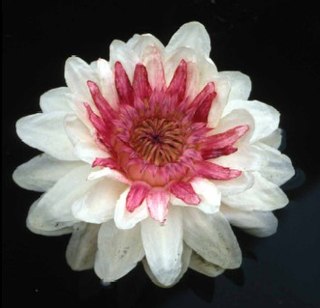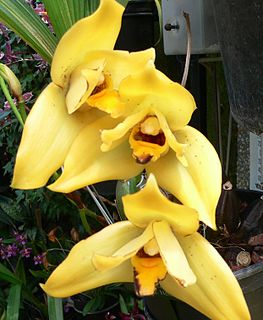
Brassavola is a genus of 21 orchids. They were named in 1813 by the Scottish botanist Robert Brown. The name comes from the Italian nobleman and physician Antonio Musa Brassavola. This genus is abbreviated B. in trade journals.

Cattleya is a genus of orchids from Costa Rica south to Argentina. The genus is abbreviated C in trade journals.

Rhyncholaelia, abbreviated Rl. in the horticultural trade, is a genus of orchids, comprising two species. They are distributed in Mexico, Guatemala, Belize, and Honduras. Both species were originally published in Brassavola by Lindley. In 1918, Schlechter erected the new genus Rhyncholaelia and moved Brassavola digbyanaLindl. 1846 and Brassavola glaucaLindl. 1839 into it.

Brassolaeliocattleya, abbreviated Blc. in the horticultural trade, is the orchid nothogenus for intergeneric hybrid greges containing at least one ancestor species from each of the three ancestral genera BrassavolaR.Br., CattleyaLindl. and Laelia Lindl., and from no other genera.

Otaara, abbreviated Otr. in the horticultural trade, is an intergeneric hybrid of orchids, with Brassavola, Broughtonia, Cattleya, Laelia and Sophronitis as parent genera.

Potinara, abbreviated Pot in the horticultural trade, is the nothogenus comprising those intergeneric hybrids of orchids which have Brassavola, Cattleya, Laelia and Sophronitis as parent genera.

Laeliinae is a Neotropical subtribe including 40 orchid genera, such as Brassavola, Laelia and Cattleya. The genus Epidendrum is the largest within this subtribe, containing about 1500 species. This is followed by the genus Encyclia, with over 120 species.

The University of North Carolina at Charlotte Botanical Gardens, sometimes called the Charlotte Botanical Gardens, are botanical gardens located at the University of North Carolina at Charlotte.

Antonio Musa Brassavola was an Italian physician and one of the most famous of his time. He studied under Niccolò Leoniceno and Giovanni Manardo. He was the friend and physician of Ercole II, the duke of Este. He was also the consulting physician of Kings Francis I, Charles V, Henry VIII and Popes Paul III, Leo X, Clement VIII and Julius III. He performed the first successful tracheotomy, and published an account of it in 1546. He was the chair of philosophy in Ferrara and also studied botany and medicine. A genus of orchid, called Brassavola, is named after him.

The Flora of Colombia is characterized by 130,000 species of plants that have been described within Colombian territory.
This page lists orchid species according to their respective distribution range.

The term grex, derived from the Latin noun grex, gregis meaning 'flock', has been expanded in botanical nomenclature to describe hybrids of orchids, based solely on their parentage. Grex names are one of the three categories of plant names governed by the International Code of Nomenclature for Cultivated Plants; within a grex the cultivar group category can be used to refer to plants by their shared characteristics, and individual orchid plants can be selected and named as cultivars.

Brassavola cucullata, common name daddy long-legs orchid, is a species of orchid native to Mexico, Central America, the West Indies and northern South America.

Brassavola flagellaris is a species of epiphytic orchid of the Cattleya alliance. It grows wild in eastern Brazil, where it fills the evening air with the citrus-like fragrance of its blossoms.

Brassavola martiana is a species of orchid found in South Tropical America. It is reported from Brazil, Peru, Colombia, Venezuela, French Guiana, Guyana and Suriname.
Brassavola angustata is a species of orchid native to Trinidad & Tobago, Guyana, Venezuela, Suriname, and Roraima.

Brassavola nodosa is a small, tough species of orchid native to Mexico, Central America, the West Indies, and northern South America. It is also known as "lady of the night" orchid due to its citrus and gardenia-like fragrance which begins in the early evening. It has been widely hybridized and cultivated for its showy flowers and pleasing scent.

Brassavola tuberculata is a species of orchid native to Bolivia, Paraguay and Brazil.

Brassavola venosa is a species of orchid found from Campeche, Oaxaca, Quintana Roo, El Salvador, Guatemala, Honduras and Nicaragua.

















